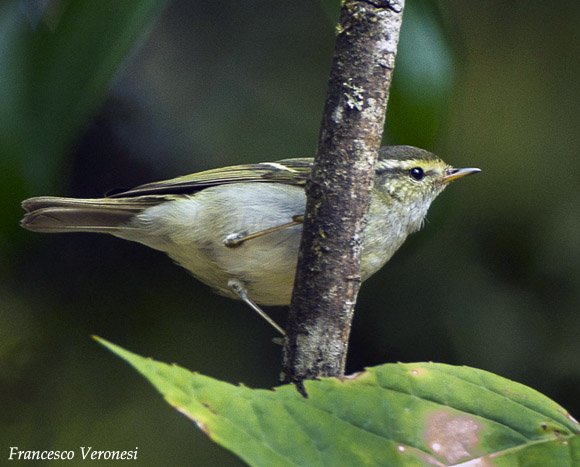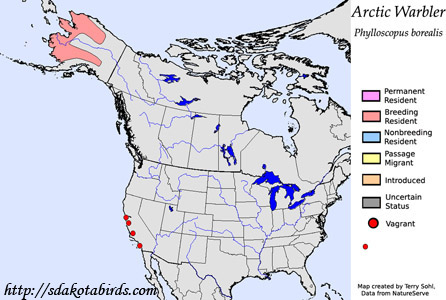| Length: 5 inches | Wingspan: 7.75 inches | Seasonality: Non-resident in South Dakota |
| ID Keys: Greenish-gray uppperparts, grayish-white underparts, single wingbar, light eyebrow with dark eyestripe | ||
 The
Arctic Warbler is primarily a bird of Eurasia, where they are found in
sub-arctic boreal forest and taiga. In North America, they have
established breeding populations in Alaska. They are one of just a few birds
that breed in North America, but overwinter in the Old World. Nearly
all Arctic Warblers, including those that breed in Eurasia, move to
southeastern Asia for the winter.
The
Arctic Warbler is primarily a bird of Eurasia, where they are found in
sub-arctic boreal forest and taiga. In North America, they have
established breeding populations in Alaska. They are one of just a few birds
that breed in North America, but overwinter in the Old World. Nearly
all Arctic Warblers, including those that breed in Eurasia, move to
southeastern Asia for the winter.
Habitat: In the North American part of their range, Arctic Warblers are mostly found in shrubby thickets and areas of dwarf willow or dwarf birch. Often found in thickets along riparian areas. They can also sometimes be found in spruce forests in central Alaska.
Diet: Feeds on insects and spiders. They have also been known to feed on small snails.
Behavior: Foraging is done by flitting and scrambling through thickets and other vegetation, gleaning insects as the move about. They often flick their wings while foraging, an activity that may help flush insects. In addition to gleaning insects while clambering about, they will also fly out to capture flying insects that have been disturbed by their activity.
Nesting: The nest of an Arctic Warbler is a dome of built of grasses, moss, rootlets, leaves, and other vegetative material, placed on the ground amongst protective vegetation. The female lays between 5 and 7 eggs and she alone incubates them. Incubation takes about 12 days, with both parents helping to feed the young after they hatch. The young fledge about 2 weeks after hatching.
Song: The song of an Arctic Warbler is a fast, monotonous trilling, preceded by one or two sharp "tchik" notes.
Migration: Migratory, with North American populations overwintering in southeast Asia.
Interactive eBird map: Click here to access an interactive eBird map of Arctic Warbler sightings
Similar Species: Can look similar in appearance to some of the more drab North American warblers, such as Tennessee Warbler or Orange-crowned Warbler.
Conservation Status: Arctic Warbler are found over a wide geographic area, are common in parts of their range, and overall populations appear to be stable. The IUCN lists the Arctic Warbler as a species of "Least Concern".
Further Information: 1) Cornell's All About Birds - Arctic Warbler
2) WhatBird - Arctic Warbler
3) Audubon - Arctic Warbler
Photo Information: Photo by Francesco Veronesi - Photo licensed under Creative Commons Attribution ShareAlike 2.0 Generic License
| Click below for a higher-resolution map |
 |
| South Dakota Status: Non-resident in South Dakota |
Additional Arctic Warbler Photos (coming soon!!)
